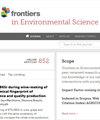流域尺度生态网络的构建与优化:库耶河流域案例研究
IF 3.3
3区 环境科学与生态学
Q2 ENVIRONMENTAL SCIENCES
引用次数: 0
摘要
导言构建生态空间网络是保障生态空间核心结构的关键。方法利用形态空间模式分析确定库叶河流域的生态源。结果与讨论研究表明,2022 年库叶河流域主要土地利用类型为林地草地、耕地和建设用地。MSPA 模型软件确定了大部分景观格局由核心区和边缘区组成,面积分别为 30324.05 hm2 和 15088.24 hm2。高生态阻力表面因子在社会经济活力区和北部地区占主导地位。阻力值从 0.02 到 0.87 不等,高阻力区和法阻力区交替出现。最小累积阻力法发现了 171 条生态走廊。而利用 19 个一级生态源相互作用矩阵的引力模型发现了 8 个相互作用力最大的一级生态廊道。具有显著影响的核心生态廊道有 137 条,附属生态廊道有 23 条。叠加国道、省道、铁路、高速等道路因素和生态廊道,共形成 38 个生态断点,每个断点都具有特定的屏障效应和法定的生态稳定性。本文章由计算机程序翻译,如有差异,请以英文原文为准。
Construction and optimisation of watershed scale ecological network: a case study of kuye river basin
IntroductionCreating an ecological space network is essential for safeguarding the core structure of ecological space.MethodsMorphological spatial pattern analysis was used to locate ecological sources in the Kuye River Basin. Using the least cumulative resistance model and gravity model, the resistance surface, ecological corridor, and ecological space management network are determined.Results and discussionThe study revealed that in 2022, the predominant land use types in the Kuye River Basin were wood land and grassland, cultivated land, and construction land. MSPA model software identifies a substantial portion of the landscape pattern as consisting of core and marginal areas, which encompass 30324.05 hm2 and 15088.24 hm2 . High ecological resistance surface factors dominate the socioeconomically vibrant zone and northern regions. Resistance values ranging from 0.02 to 0.87, and high and law resistance zones alternate. The minimal cumulative resistance approach found 171 ecological corridors. And gravity model using the interaction matrix of 19 primary ecological sources discovered 8 first-level ecological corridors with the highest interaction force. There are 137 core and 23 subsidiary ecological corridors with significant affects. Overlying the road factors and ecological corridors of national highways, provincial roads, railways, and high-speed roads creates a total of 38 ecological breakpoints, each characterized by specific barrier effects and legal ecological stability.
求助全文
通过发布文献求助,成功后即可免费获取论文全文。
去求助
来源期刊

Frontiers in Environmental Science
Environmental Science-General Environmental Science
CiteScore
4.50
自引率
8.70%
发文量
2276
审稿时长
12 weeks
期刊介绍:
Our natural world is experiencing a state of rapid change unprecedented in the presence of humans. The changes affect virtually all physical, chemical and biological systems on Earth. The interaction of these systems leads to tipping points, feedbacks and amplification of effects. In virtually all cases, the causes of environmental change can be traced to human activity through either direct interventions as a consequence of pollution, or through global warming from greenhouse case emissions. Well-formulated and internationally-relevant policies to mitigate the change, or adapt to the consequences, that will ensure our ability to thrive in the coming decades are badly needed. Without proper understanding of the processes involved, and deep understanding of the likely impacts of bad decisions or inaction, the security of food, water and energy is a risk. Left unchecked shortages of these basic commodities will lead to migration, global geopolitical tension and conflict. This represents the major challenge of our time. We are the first generation to appreciate the problem and we will be judged in future by our ability to determine and take the action necessary. Appropriate knowledge of the condition of our natural world, appreciation of the changes occurring, and predictions of how the future will develop are requisite to the definition and implementation of solutions.
Frontiers in Environmental Science publishes research at the cutting edge of knowledge of our natural world and its various intersections with society. It bridges between the identification and measurement of change, comprehension of the processes responsible, and the measures needed to reduce their impact. Its aim is to assist the formulation of policies, by offering sound scientific evidence on environmental science, that will lead to a more inhabitable and sustainable world for the generations to come.
 求助内容:
求助内容: 应助结果提醒方式:
应助结果提醒方式:


